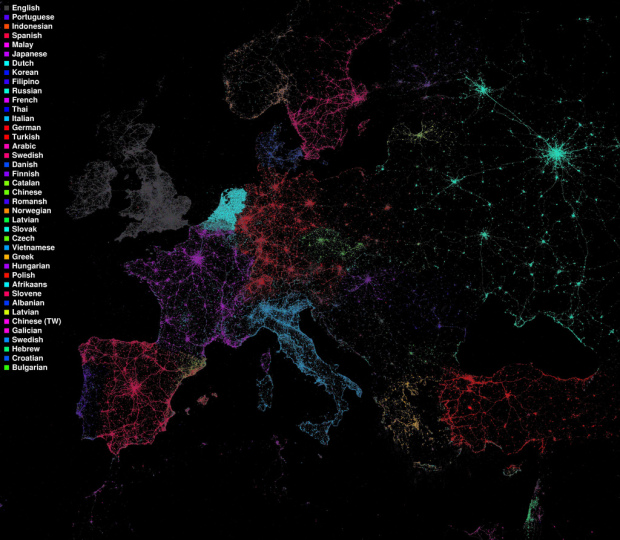Eric Fischer maps language communities on Twitter using Chrome’s open-source language detector. Each color, chosen to make differences more visibly obvious, represents a language. English is represented in dark gray, which is used just about everywhere, so it doesn’t obscure everything else.
The emergence of borders without actually drawing them in is interesting. There’s a little bit of blending, but the splits are pretty well-defined. Especially in the Netherlands, where the tweet dispersal seems to be abnormally dense in that area. What’s going on over there?
There’s also a world version, but Europe is where all the action’s at.
[Language communities via @enf]


 Visualize This: The FlowingData Guide to Design, Visualization, and Statistics (2nd Edition)
Visualize This: The FlowingData Guide to Design, Visualization, and Statistics (2nd Edition)

It seems to me that the area where there is an unusual blending is in fact Belgium, and not the Netherlands. As you certainly know, Belgium is a multi-lingual country, with three official languages: French, Dutch, and German.
The Netherlands are on of the heaviest electrified regions in Europe. Compare the Twitter-Map with my light pollution map at http://kartenwerkstatt.at/#!/map/globe-noaa-nighttime-2009 and they almost look the same.
Just like Belgium, Switzerland also tends to disappear because it has four major language groups.
Looks like Latvian is represented by two colors, while Lithuanian doesn’t have any.
Ouch, you are correct about the missing Lithuanian. The first Latvian should actually read Lithuanian. Thanks for noticing!
swedish is also represented by two colours.
The second Swedish should actually be Swahili. I corrected the caption on Flickr if you click through to there.
Hi Nathan,
According to data from PeopleBrowsr in San Francisco, the Netherlands is the nation with the second highest Tweets per capita, exceeded only by Singapore, see: http://www.140characters.com/2010/05/26/tweets-per-capita/.
So aside from the high population density and general high levels of technology use, Twitter adoption seems to be particularly high in the Netherlands.
Best wishes,
Peter
No wonder Dutch tweets are TT regular…Only such a shame it’s mostly about football…
Btw, The Netherlands is still easily discerned from Belgium though half of belgium shares “the same language”, most notably due to heavy internet use in The Netherland compared to Belgium…I wonder why that’s so?
is not the Basque language present??
There are unfortunately very few geotagged tweets in Basque. I hope as people continue to tweet there will later be enough to make them a visible presence on the map.
If Catalan is clearly present in this map. Why is not twitter site available in this language… #twitterencatalàja!!!
Thank you for the map, great job Eric!!
Meritxell
As a Dutch person, who lives in Finland, I have a theory: before the wide adoption of Facebook by Europeans there was a near monopoly of a social networking site called Hyves. Facebook still has difficulties breaking this monopoly. And surprise, surprise, Hyves has a fairly easy way to connect one’s twitter profile to the Hyves profile! There is your answer to the twitter density. As for the blending, the North of Belgium is Dutch-speaking, the South is french-speaking (and there is indeed a small German community).
Is this indeed the Twitter volume? Or “just” Twitter volume that has a geographical location attached? The density in this map might not just be Twitter volume and language related, but also in part “geographically minded” and/or smartphone-with-GPS-built-in density related…?
It is not the total Twitter volume, only tweets with geotags, which I think is about 1% of the total volume of Twitter. So yes, it definitely depends on the fraction of people posting from smartphones, and the fraction of those who have decided to reveal their locations.
Amazing! Reminds me of the global night lights in multicolor! Look at the World image in Original Size! Very detailed… Japan shines brightly!
I just HAD to comment, because I am really awestruck that someone even THOUGHT to turn language demographics into a work of art! What a creative and aesthetically compelling way to convey a statistic… My stats teacher was right, we can do much more than I’ve considered! Bravo on this… I downloaded a copy to study a bit more. :)
(I found this stat/site via: http://prostheticknowledge.tumblr.com)
Look at the catalan case. Maybe the major singularity, apart from Belgium, in the map’s rigid state-language boundaries. And you can see how spanish red and catalan yellow form a new orange zone in the Barcelona area. And how the mix of catalan, spanish, german, english… give Balearic Island a strange mixed colour.
pd. It’s strange that there are few areas in the map with such a multilingual colours
do you have any numbers related to the amount of tweets in each language so we might see the all the languages.
You are right Meritxell, Catalan twitters seem to be much more active but twitter don’t want to translate it.
What a shame.
G.
Actually, the Netherlands is not that well-defined at all. The sparser area towards the bottom left of that Dutch-speaking area is actually the Dutch-speaking part of bilingual Belgium.
may be, the difference between the abundance and lack of tweets in some countries is because of popularity of Internet services which are used in the regions? We all know that different countries use different services – not only twitter or facebook. Try to research vkontakte or odnoklassniki which are used by slavonic peoples.